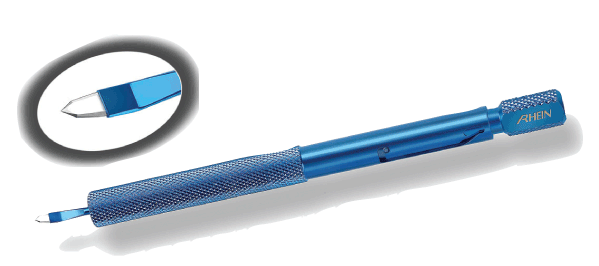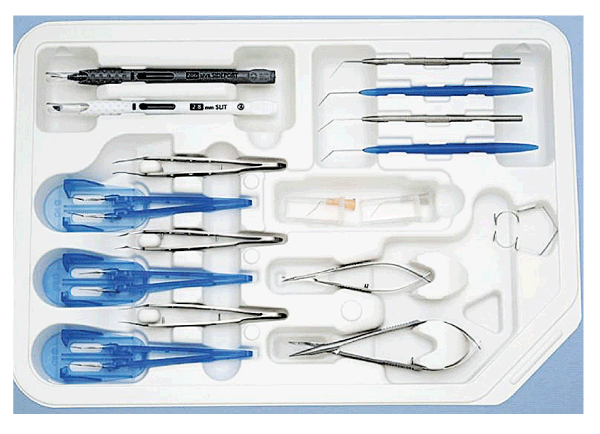Rhein Medical has announced two new diamond knives designed to facilitate the new Stellaris incision requirement. The knives are 1.8 mm in width, and render an extremely sharp incision. The first knife, (05-5103 3-D Blade, Angled Handle, 1.75 mm to 1.95 mm Blade), renders a unique incision that provides a more tortuous path, helping to seal the incision. It also has asymmetrical bevels causing it to push tissue in three directions. The second knife: 05-5104 3-D Blade, Angled Handle, 1.80 mm to 2.2 mm Blade. Contact Rhein Medical at (813) 885-5050 for more information.

Endo Optiks Launches Series of High-Resolution Micro-Endoscopes
Endo Optiks has launched the High Resolution Series of Micro-Endoscopes. The new micro-endoscopes are designed to provide a better image and a wider field of view. High resolution is made possible by a new 17,000-pixel fiber optic bundle, which is a 70-percent increase in pixels over current micro-endoscopes. As each pixel represents a single point of a video image, the High Resolution Series will greatly enhance the quality and detail of the image seen on the video screen, the company says. The new scopes also expand the field of view to 160 degrees, which allows surgeons to see more and get a better view of difficult-to-reach areas of the eye. Current endoscopes, with 10,000 pixels and a 110-degree field of view, will continue to be available from Endo Optiks.
Two High Resolution Endoscopes are available: The Triple Function Micro-Endoscope combines laser, light and imaging and has a 19-ga. probe; Triple Function scopes will be available in both Straight and Curved Tips. The Dual Function Micro-Endoscope combines light and imaging and has a 20-ga. probe; Dual Function scopes have a straight tip. For information, visit endooptiks.com.
Expanded Line of BD Visitec Single-Use Microsurgical Instruments, Customized Trays
BD Medical-Ophthalmic Systems, a unit of BD (Becton, Dickinson and Co.), has launched an expanded line of BD Visitec stainless-steel single-use instruments. With the addition of 30 new instruments and customized trays, health-care facilities have the potential to increase efficiency by eliminating the need for costly and time-consuming re-sterilization of each product.
"Advances in ophthalmic surgical techniques make it possible for surgeons to perform more procedures in less time, thereby increasing the number of patients who can benefit from improved vision," said Randall Olson, MD, CEO of the John A. Moran Eye Center and chairman of the Department of Ophthalmology and Visual Sciences at the University of Utah. "However, this increase in ophthalmic procedures is leading to growing concern over instrument sterility. In this environment, single-use instruments can provide ophthalmic surgeons with immediate access to sterile instruments." BD Visitec stainless steel instruments help to further patient and health-care worker safety with high-quality, innovative, safety-engineered products designed to eliminate the risk of transmitting infectious agents, BD says. For information, please visit bd.com/ophthalmology.

From B&L Storz, the Akahoshi Prechop Forceps
Bausch & Lomb Storz now offers the Singh Akahoshi Prechop Forceps with Paddle Tip. The Singh Akahoshi Prechop Forceps is used during cataract surgery for the prechop technique to segment the lens nucleus prior to phacoemulsification. The thin paddle design of the tip allows for ease of insertion into the lens nucleus, while the broad surface of the tip provides excellent splitting action. The instrument is initially introduced into the lens, and the handle is compressed to create one central chop. The lens halves are then rotated and split to form quadrants. The versatile cross-action tip can be used in a multitude of incision sizes, including the popular MICS 1.8-mm procedure. For information or to obtain a quote, visit storzeye.com or call 1 (800) 338-2020.
OCT Devices Incorporate BluePeak Technology
Heidelberg Engineering announced two new additions to the Spectralis family of multi-modality ophthalmic imaging devices. The new models add BluePeak laser autofluorescence to the company's more economical spectral-domain OCT (SD-OCT) devices.
"BluePeak autofluorescence adds a functional indicator of retinal health by measuring the metabolic activity of the RPE," said Karl Csaky, MD, PhD, of the Retina Foundation of the Southwest. "Recent results from the Geographic Atrophy Progression study clearly demonstrate the need to use autofluorescence to track the progression of geographic atrophy for dry AMD patients. This has attracted the interest of the pharmaceutical companies; at least 10 new therapies for dry AMD are now under clinical investigation. The combination of BluePeak and OCT will enable clinicians to potentially take advantage of these emerging therapeutics in the same way that ranibizumab and OCT changed the management of wet AMD."
BluePeak laser autofluorescence is now available on five of the Spectralis models. There are now seven different Spectralis models available. The main differences between the models are which of the available imaging modalities they include, whether the instrument is set up for Wide Field imaging, and hardware upgrade options. Product line details are available at HeidelbergEngineering.com.



